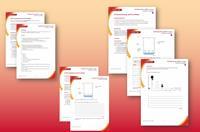Check your learners’ understanding of experimental skills and strategies
This resource accompanies the article How to teach practical planning, part of the Teaching science skills series in Education in Chemistry.
Use these exam-style questions to see if learners can evaluate given methods, make suggestions for improvements, select appropriate apparatus and plan experiments. The questions are based on chromatography, making salts and neutralisation practicals. Two versions of the worksheet are available depending on support needs of your learners.
Learning objectives
- Identify the mistakes in methods for planned practical experiments.
- Explain why the mistakes you have found would not lead to a valid outcome.
- Select the appropriate equipment needed to carry out a given investigation.
- Plan a method that would lead to a valid outcome.

This resource is part of our Teaching science skills series, bringing together strategies and classroom activities to help your learners develop essential scientific skills, from developing hypotheses to understanding ethics.
How to use this resource
There are several ways you could use this resource:
- As part of a revision lesson on required practicals or working scientifically.
- As part of separate lessons on chromatography, making salts or titrations (neutralisation). Giving the questions at the end of a practical lesson or at the start of the following lesson.
You may wish to use one or more of the techniques below:
- Complete the questions as a ‘walking talking’ mock. Explain how to determine what the question is asking and prompt learners to highlight the key words/command words.
- Get learners to complete the questions under timed exam conditions, go through the answers and have them make improvements.
- Use cold calling to choose learners and check for understanding.
- Show learner answers under a visualiser and discuss with the class.
Scaffolding
Use the support worksheet (indicated with an ‘S’ icon in the header) when additional support with the questions is needed.
Answers
A mark scheme for both worksheets can be found in the teacher notes.
More resources
- The core practical videos in our series each offer a host of supporting resources including pause-and-think questions, integrated instructions and intended outcomes to help ensure purposeful practicals.
- Connect the skills of developing hypotheses and planning practicals with this candle burning investigation.
- Get learners interpreting practical instructions including integrated instructions with this worksheet.
- Use CIDER (control, independent, dependent, equipment, risk assessment) grids, to help learners remember and understand methods for key practicals.
- Give your 14–16 learners a chance to devise an experimental investigation into catalysts’ and rate of reaction using the context of the Kursk submarine.
- Meet Tilly, an analytical chemist in healthcare, who uses her skills in planning experiments to help fight infectious diseases.
Downloads
Practical planning teacher notes
Handout | PDF, Size 0.17 mbPractical planning teacher notes
Editable handout | Word, Size 0.42 mbPractical planning student sheet
Handout | PDF, Size 0.2 mbPractical planning student sheet
Editable handout | Word, Size 0.49 mbPractical planning student sheet support
Handout | PDF, Size 0.34 mbPractical planning student sheet support
Editable handout | Word, Size 0.56 mb



















No comments yet